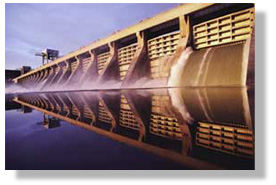With increasing frequency, Nebraskans are asking, "how much of the energy used in the state comes from renewable sources?" While the number is ever changing – the amount of energy changes yearly as do the sources from which the energy is derived – the Energy Office has quantified the number and the sources more definitively than ever before.
 Hydro Electric Dam
Hydro Electric Dam
In 1999, 4 percent of Nebraska’s energy consumption was met using renewable sources. Nebraska consumed energy from six categories of renewable sources:
- Ethanol
- Geothermal energy
- Hydroelectric power
- Solar energy¹
- Wind energy
- Wood and waste²
The state consumed 602 trillion British thermal units of energy in 1999 including 24.122 trillion British thermal units from renewable energy sources. Shown in the table below, Nebraska consumed 1,736 gigawatthours of hydroelectric power, 153,000 cords of wood, 18,599,674 gallons of ethanol, 0.32 trillion British thermal units of geothermal energy, 0.016 trillion Btu of solar energy, and 0.02 trillion British thermal units of wind energy.
|
Hydroelectric Power |
18.000 trillion Btu³ |
(1,736 gigawatthours) |
Wood and Waste² |
3.700 trillion Btu |
(153,000 cords) |
Ethanol |
2.100 trillion Btu |
(18,599,674 gallons) |
Geothermal Energy |
0.320 trillion Btu |
Solar Energy¹ |
0.016 trillion Btu |
Wind Energy |
0.020 trillion Btu |
Renewable Energy Consumption |
24.156 trillion Btu |
Total Energy Consumption |
602.000 trillion Btu |
In 1999, hydroelectric power was almost three-fourths of renewable energy consumption in Nebraska. Renewable energy consumption was 4 percent of total energy consumption in 1999, the most recent year for which data is available. If hydroelectric power is excluded, renewable energy consumption was 1 percent of total energy consumption. If both hydroelectric power and ethanol are excluded, then only 0.7 percent of total energy consumption came from renewable resources in 1999. Notes: ¹Solar energy includes solar thermal and photovoltaic energy. ²Wood and waste is one energy source from the biomass category. ³Consumption is listed in British thermal units, or Btu, to enable totaling all the categories of energy. Sources: State Energy Data Report 1999, Consumption Estimates. Energy Information Administration, Office of Energy Markets and End Use, U.S. Department of Energy, Washington, DC. Lincoln Electric System. Inventory of Electric Utility Power Plants in the United States 1999. Energy Information Administration; Office of Coal, Nuclear, Electric and Alternate Fuels; U.S. Department of Energy; Washington, DC. Inventory of Nonutility Electric Power Plants in the United States 1999. Energy Information Administration; Office of Coal, Nuclear, Electric and Alternate Fuels; U.S. Department of Energy; Washington, DC. Electric Power Annual. Energy Information Administration; Office of Coal, Nuclear, Electric and Alternate Fuels; U.S. Department of Energy; Washington, DC. Nebraska Ethanol Board. Home Energy Loans Energy Statistics |